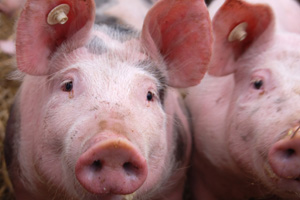Colistin resistance found in Chinese pigs and poultry

A new form of antimicrobial resistance has been discovered in Chinese poultry and pigs, which is called a threat to the ‘last line of antibiotics’.
This was reported in a recent article in the scientific medical journal The Lancet Infectious Diseases. Bacteria have been shown to be resistant to the antibiotic colistin.
Direct link between resistance in animals and humans
In the research, a direct link has been established between the usage of the antibiotic in animal husbandry and the resistance found in slaughtered animals, in food and in humans. This resistance, caused by a new mutation dubbed the MCR-1 gene, would also be capable of spreading.
The first sign for colistin resistance was found about four years ago at a pig farm near Shanghai. When the resistance in the lab proved to be transferrable, further trials were carried out to samples of slaughter pigs from four provinces as well as of pork and poultry meat from tens of supermarkets as well as wet markets. In addition, samples were taken from diseased people in hospitals.
Worries about the resistance
A large share of the animals (about 20%) as well as the meat (about 15%) turned out to carry resistant bacteria. The researchers predominantly worry about the resistance, as bacteria can exchange this amongst each other, but also in between species. The resistance was found in E. coli bacteria. Transfer of this resistance proved possible to e.g. Klebsiella pneumoniae or Pseudomonas aeruginosa (in humans both cause respiratory disease).
Since the resistance was found in humans in relatively few cases – when compared to animals, that is – it looks probable that this type of resistance originated in animals and was transferred to humans, explained the Prof Jianzhong Shen, one of the authors of the research and attached to the Beijing Advanced Innovation Center for Food Nutrition and Animal Health at the China Agricultural University. He says colistin is being used quite a lot in animal husbandry. Worldwide, The Lancet estimates agriculture purchases around 12,000 tonnes of colistin per year.
Reactions to the research
As a result of the research, the Chinese ministery of agriculture has decided to better monitor the usage of the antibiotic colistin. There is also evidence that the resistance might have spread to Laos and Malaysia, according to the BBC.
Prof Mark Wilcox, from Leeds Teaching Hospitals NHS Trust, told the BBC: “The transfer rate of this resistance gene is ridiculously high, that doesn’t look good.”
As a result of the study, in the Netherlands, control for colistin resistance shall be increased, Prof Dr Dik Mevius of the Central Veterinary Institute told agricultural newspaper Boerderij Vandaag.
Not the first report of colistin resistance
It is not the first report of resistance of bacteria against colistin. In earlier reports, this was discovered in India. In the report of the European Centre for Disease Prevention and Control (ECDC), however, this was not noted.











